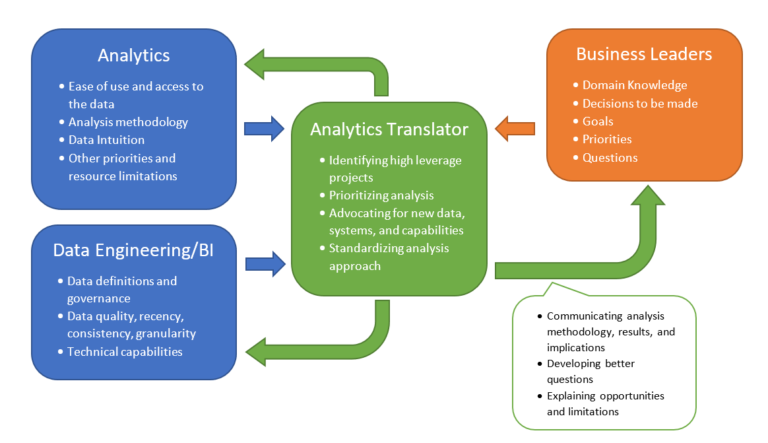Throughout my 15+ year career in analytics I have seen data projects that soared, and those that sank. What makes the difference is how well the players understand each others’ goals and capabilities. Communication is critical on both sides of analytics. The business needs to understand when and how the data can help them. The analysts need to understand business questions and goals.
The person that connects these two functions is an Analytics Translator. Many companies missed the point in time when the need for this role arose, and don’t have anyone in an analytical position high enough to play it. If you ever wondered how to make your analytics group more productive, deliver better value for the business, and keep the analysts happy, read on to see whether an Analytics Translator can help you.
Analytics Translators work with the business leaders to find projects where analytics can help choose the right course of action, and prioritize them. They translate the problems into analytical questions to be answered while taking into account data quality and resource availability.
In other words, they help turn a business decision into a question that can be answered by the data. They also help the business understand the answer, and how to operationalize it or turn it into decisions.
Why are translators so important? They help ensure that organizations achieve real impact from their analytics initiatives (which has the added benefit of keeping data scientists fulfilled and more likely to stay on, easing executives’ stress over sourcing that talent).
While Analytics Translators help organizations take their analytics to the next level, they also improve the efficiency of the analytics group and increase the job satisfaction of the analysts.
Here are my 10 signs your organization needs someone to link your analytics team and the business in a meaningful way:
1. Your business makes data requests (aka specs), not asks questions.
This is a sign that the business took it upon themselves to define how they want their questions answered and with what data. This happens when data science is not involved early in the process of defining the research question, often because the organization’s analytical capabilities are behind its needs. To have a real impact, the Analytics Translator needs to engage the business to understand the problem, define the question, and ways in which it can be answered.
2. There is poor prioritization of analytical projects or data requests.
Prioritization comes from understanding both where the business needs are as well as analytics capabilities to address those needs, whether existing or in the process of development. A great Analytics Translator is able to show the value of data by identifying and executing the high leverage projects.
3. Your analysts are “data squirrels”, fetching the data and packaging them into output files or reports, and not producing insights.
This is another sign that the business is taking on the job of designing the analysis methodology and interpreting the results. The function of choosing the analytical approach and teasing out the insights belongs in analytics, and to better serve business needs, analytics needs to be involved beyond creating queries.
4. The analytics queue is an endless cycle of follow-ups and partial data requests.
When defining how the questions are answered (metrics, analysis design) is done by the business, the business is going to have their questions answered by trial and error. This creates a flurry of specs to try to approach the question from many angles.
To reign this cycle in, the Analytics Translator should be able to find the data and design that answers the question best, thus reducing the need for redundant and follow up requests.
5. The data answers are hard to interpret and often make things more confusing.
“But this is what you asked for!” – if this is the justification you as a business leader hear too often, and you as an analyst have to give, you have a “garbage in, garbage out” situation.
In this case, typically, analysts are not involved in defining how the question is being answered, and the results are not pretty. There is also nobody to help interpret the data for the business at the end of the process, which is the role of Analytics Translator.
6. All of your programs show great results, yet the top/bottom lines are getting worse.
There are many ways to assess the effectiveness of programs, and some metrics are better than others. When analytics does not weigh in on how to answer questions, the business leaders set the methodology. Out of many ways to measure performance, the ones that make them look best are often chosen. Thus, the company sees a proliferation of great program results with no improvement in revenue or profits.
7. Business does not ask better questions over time.
One of the beauties of the analytics profession is that a really good answer to a question will lead to a better understanding of the matter, and thus better, more insightful questions next time. In the immortal words of Robert Sheckley, “In order to ask a question you must already know most of the answer.”
Better questions produce better insights. Better insights raise better questions. This cycle of improvement becomes possible if you have a good Analytics Translator.
8. There are no established ways to measure results.
Standardized ways offer consistency, over time as well as among different programs. The results can be compared and put in context. Without the use of standardized methods, the business will try a variety of methods, and they will likely settle on the metric that justifies their approach best.
9. Many requests ask for exotic or hard to get data.
Not being familiar with the data, the business often asks for unreliable or hard to get data when more reliable, high quality, standardized data is available. This is especially common when answering a difficult question.
The Analytics Translator can make the business aware of the amount of effort it takes to obtain, clean, and process some of the data, and how it impacts the turnaround time and quality of the results.
10. Your analysts and data scientists are dissatisfied with their jobs.
Good analytical talent is hard to recruit and retain. Analysts get their job satisfaction from answering challenging questions and seeing their results positively impact the business. No analyst wants to man a queue of specs that come from people with limited familiarity with the data.
How to make an Analytics Translator effective in their role?
From these many examples, it is clear that the Analytics Translator should be able to get into the process of defining projects early enough to influence whether the business question is worth addressing and how it can be executed. Metrics and research design need to be defined at this early stage, or a separate sub-project needs to be created to understand which metrics work best in this particular case.

The involvement of someone close to the data is also critical when the data sources are considered. There is a difference in accuracy, availability, reliability, recency, frequency of update, and granularity of the data to take into account. Having someone who knows the data involved from the beginning can significantly reduce the turnaround time of the analysis and improve analyst job satisfaction.
How do you find someone to take the Analytics Translator role?
This HBR article rightfully notes that hiring an Analytics Translator from the outside is suboptimal because “new hires lack the most important quality of a successful translator: deep company knowledge”.
Since this profession exists at the intersection of domain knowledge and analytics, you should look for analytically minded business people or business minded analysts. Your best bet is probably someone in the analytics department who has been with the company long enough to understand the business and build personal networks.
This person should have shown the ability to work with the stakeholders, to create value from analytics, and to communicate well.
Data science can’t happen in a silo. It must be tightly integrated into the business organization, operations and processes.
Integrating data science into the organization is not easy, but the benefits are worth the effort. If you are willing to take the first step, consider creating an Analytics Translator role.
If you want to learn more about my experience translating business problems into analytical questions, feel free to connect with me on LinkedIn and send a message.
